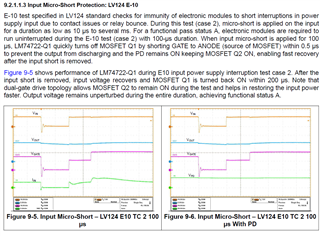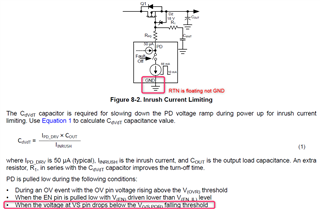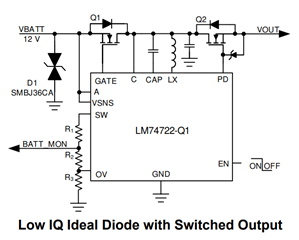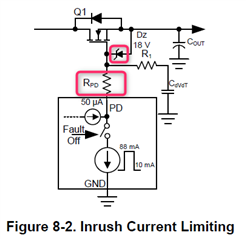How PD/ MOSFET Q2 remains ON during short interruption.

The PD is pulled down when voltage at VS pin drops below the V(VS POR) falling threshold during short interruption right?

Therefore, the source and gate is shorted and PD will be off right?
This thread has been locked.
If you have a related question, please click the "Ask a related question" button in the top right corner. The newly created question will be automatically linked to this question.
How PD/ MOSFET Q2 remains ON during short interruption.

The PD is pulled down when voltage at VS pin drops below the V(VS POR) falling threshold during short interruption right?

Therefore, the source and gate is shorted and PD will be off right?
Hi Vishwas,
The VS or the C pin which supplies power to the internal circuits of the IC is connected to the common drain point. So, when the input falls below output voltage during short interruption, the DGATE is immediately turned OFF and does not allow C pin voltage to discharge. Remember, the C pin is powered from Vout (through Q2 or its body diode) when Vin starts dropping below Vout.

So, the C pin is powered as long as the output capacitor is above V(C) POR Falling threshold.
Hi,
So, the PD remains ON means the current is flowing through body diode right during short interruption?
How PD remains ON (how the current direction changes suddenly from VOUT to C) and what will be the voltage across the PD?
During input short interruptions, the DGATE is OFF for reverse current blocking and the C pin which is connected to common drain point is disconnected from input. The PD remain ON because, the C pin voltage is powered from Vout when Vin drops to 0V during short interruptions.
okay the voltage across PD will be then VOUT + boost regulator output (max 15.5V).
The maximum voltage across the gate will be 15.5V + the voltage across VOUT. So, why do we need 18V zener why can't we use a normal diode during PD pulled low condition?


Also, any recommendation for RPD value for 12V battery system?
A zener is required because during conditions like output transients/short circuit, the Vout can drop to zero quickly but the PD will not be able to discharge so fast resulting in GATE-SOURCE voltage of the FET exceeding the Vgs rating of the FET which can damage it. To avoid damage to the FET in such conditions, a zener across PD to FET Source is recommended.